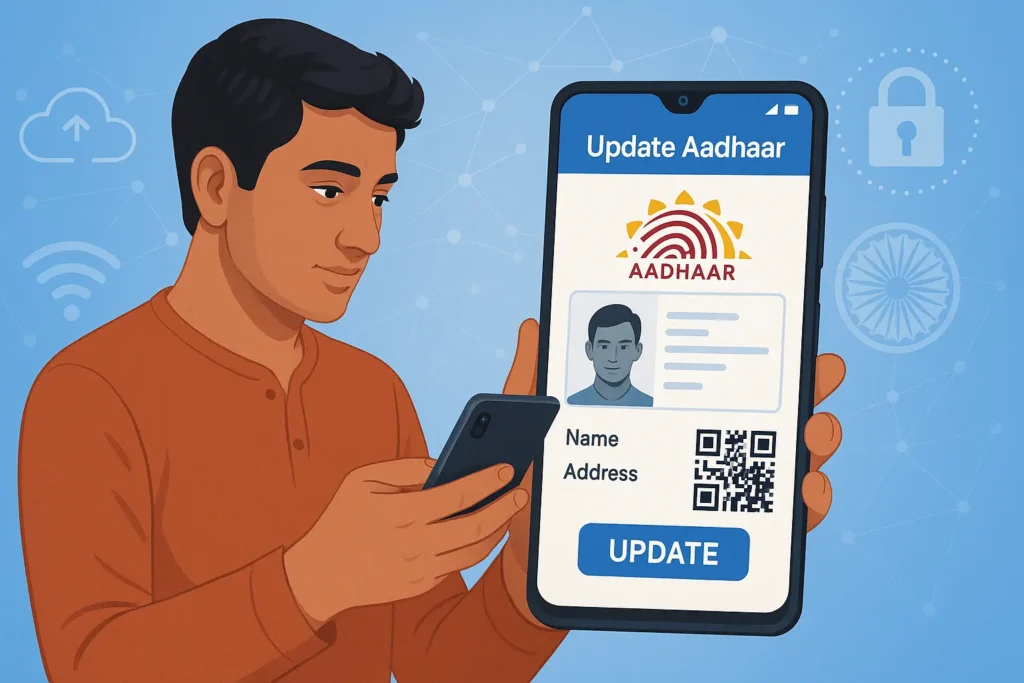For years, updating Aadhaar details meant standing in long queues, carrying multiple documents, and waiting for approvals. Whether it was a simple address change or linking a new phone number, the process was often slow and inconvenient.
That’s about to change. The Unique Identification Authority of India (UIDAI) is working on a brand-new e-Aadhaar app, designed to let citizens update most of their Aadhaar details directly from their smartphones. This upcoming app is part of India’s broader Digital India vision, aiming to cut down paperwork, reduce identity fraud risks, and make life easier for over a billion Aadhaar users.

Key Highlights
- UIDAI is developing a new e-Aadhaar mobile app for faster and easier Aadhaar updates.
- Users can update name, address, date of birth, and mobile number directly from their phones.
- The app will use AI, Face ID, and OTP verification for security.
- Biometric updates (fingerprint, iris scans) will still need Aadhaar Seva Kendras from November 2025.
- The app is expected to launch by the end of this year (2025).
- UIDAI is also rolling out related initiatives like the Aadhaar Good Governance Portal and a feature to deactivate Aadhaar after death.
What is the e-Aadhaar App?
The e-Aadhaar app is a digital platform under development by UIDAI. It will serve as a one-stop solution for updating Aadhaar information. Instead of visiting Aadhaar Seva Kendras for routine updates, people will be able to log in to the app, verify their identity, and request changes in just a few clicks.
According to government officials, the app is on track for a launch by the end of 2025. Some reports suggest that from November 2025, only biometric updates like fingerprints and iris scans will still require physical visits, while everything else can be handled through the app.
What Details Can Be Updated?
Through the e-Aadhaar app, users will be able to update:
- Name
- Residential address
- Date of birth
- Mobile number
This means most demographic details can be corrected or updated without paperwork-heavy visits. However, biometric updates will continue to require Aadhaar Seva Kendra visits for security reasons.
Security First: AI and Face ID
One of the standout features of the e-Aadhaar app is its integration of Artificial Intelligence (AI) with Face ID technology. Instead of depending solely on OTPs or passwords, users will authenticate themselves using facial recognition.
This method not only speeds up the login process but also reduces the chances of identity fraud, misuse, or unauthorized access. Combined with OTP verification, it adds another strong layer of protection.
📌 Read More
Smarter Document Support
Another key upgrade is how the app will handle supporting documents. UIDAI plans to make the app smart enough to auto-fetch verified data from government databases. This means users may not need to manually upload documents for every change.
The app could pull details from:
- Birth certificates
- PAN cards
- Passports
- Driving licences
- Ration cards under the Public Distribution System (PDS)
- MNREGA records
- Electricity bills (for address verification)
By cross-verifying with official sources, the app will cut down on delays and make updates more seamless.
Aadhaar Good Governance Portal
The app is not the only digital upgrade in Aadhaar services. The Ministry of Electronics and Information Technology (MeitY) has also launched the Aadhaar Good Governance Portal.
This portal is designed to simplify how Aadhaar authentication requests are approved and processed. By making the submission and clearance process more efficient, it ensures faster services for citizens and more transparency for service providers. It’s another step in making Aadhaar not just widely used, but also more reliable and user-friendly.
Deactivating Aadhaar After Death: A Thoughtful Update
Alongside the upcoming app, UIDAI has quietly rolled out a sensitive but important feature on its myAadhaar portal — the ability to report the death of a family member and deactivate their Aadhaar.
Previously, Aadhaar numbers of deceased individuals often remained active, which could create confusion or even open the door for misuse. Now, family members can log in to the myAadhaar portal, report the death, and request deactivation.
The process is straightforward:
- Log in to the myAadhaar portal.
- Select “Report Death of a Family Member.”
- Fill in details of the deceased and upload supporting documents.
- Submit the request.
Once verified, the Aadhaar will be marked as “deactivated.” This update ensures cleaner government records and reduces the chance of fraud, while also easing the burden on families during difficult times.
Benefits of the e-Aadhaar App
The upcoming app brings several advantages:
- Convenience: Users can update Aadhaar from home.
- Time-saving: No need for repeated trips to Aadhaar Seva Kendras.
- Faster processing: Automated checks can speed up approvals.
- Reduced paperwork: Auto-fetching documents means fewer manual uploads.
- Security: Face ID and AI reduce fraud risks.
For elderly citizens, rural residents, and busy professionals, this could be a game-changer.
Challenges and Limitations
Despite its promise, the app will have some limitations:
- Biometric updates will still require physical visits.
- Mobile number changes remain sensitive and may require strict checks.
- Internet access issues could make adoption harder in rural areas.
So while the app will ease many pain points, Aadhaar Seva Kendras will still play a role.
Global and Bigger Picture Impact
India’s Aadhaar system is already the world’s largest digital ID program, with over a billion users. The launch of the e-Aadhaar app could set a new global standard for mobile-first identity management.
Countries in Africa, Asia, and Latin America are watching closely, as many are developing or expanding their own digital ID systems. A successful rollout of the e-Aadhaar app could inspire similar solutions worldwide, showing how digital identity can be secure, scalable, and user-friendly at the same time.
Conclusion
The e-Aadhaar app represents the next big step in making India’s identity system more digital, secure, and user-friendly. By allowing updates for name, address, date of birth, and mobile number through a smartphone, UIDAI is reducing hassle and empowering citizens.
With added features like AI-driven Face ID, auto-fetching of official documents, and the new Aadhaar Good Governance Portal, the entire Aadhaar ecosystem is moving toward greater efficiency and transparency.
And with thoughtful features like deactivation of Aadhaar after death, UIDAI is addressing real-world concerns while ensuring records remain clean and secure.
If the rollout happens smoothly by the end of 2025, the e-Aadhaar app could become one of the most important digital tools for Indians — and a global model for digital identity systems in the years to come.



